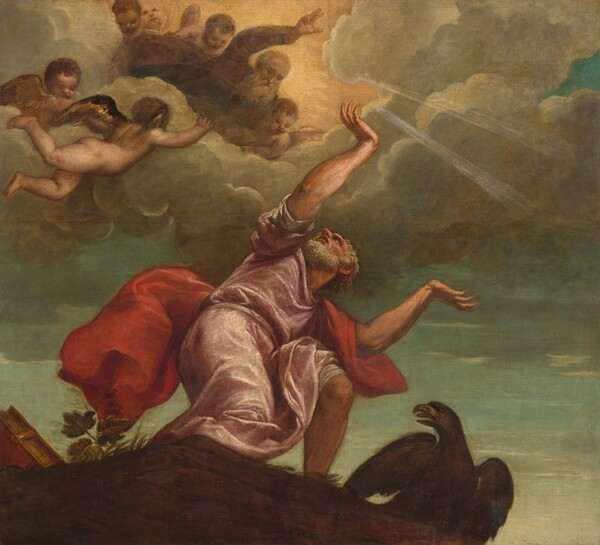The painting “Saint John the Evangelist on Patmos” was created by Titian in 1553-1555 in Venice, Italy. The artistic medium used by the author is oil on canvas. Overall painting size is 237,6 to 263 cm, while the framed size is 265,5 to 290,9 cm. Thus, the scale of the canvas is large, which makes all the details clearly visible. The colors and techniques used by Titian in his work enhance the emotional impact which the depicted plot has on the viewer. The author also emphasizes the centrality of the Prophet in the plot and his interaction with divine revelation through composition.
The painting illustrates the revelation which Saint John received about the Second Coming of Christ, which led him to write the Book of Revelations. The figure of the Prophet occupies the central part of the picture; the upper part is occupied by the image of heaven, God, and angels. The viewpoint is directed upward, which elevates the heavens and gives the impression of participation. The colors of the painting are muted but bright enough. The Prophet is dressed in pink and red clothing, which makes him outstand from the landscape. Heaven is depicted in blue and gray tones with green color; yellow is used to portray divine revelation and illumination. The lower part of the painting is presented in dark brown to create contrast.

The sky is located close enough to the Prophet figure, which makes it part of the composition. This arrangement makes it clear that God communicates directly with Saint John to provide him with revelation. The facial features of the Prophet are most detailed, which makes him the main figure. At the same time, the features of angels and God are presented more blurry. The lines are also clearly visible when considering the figure of Saint John; the contours of his body are detailed, which is not represented in the other elements.
The upper part of the picture is light, while the lower part is dark. This fact speaks of the author’s desire to emphasize the glow which comes from heaven. The viewer can also see how the fabric of the Prophet’s clothes reflects the light, which highlights its structure. In general, individual strokes are difficult to notice in the picture, which makes the image smooth in structure.